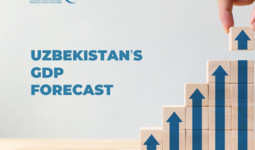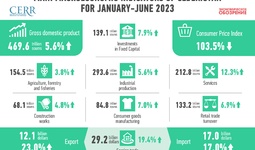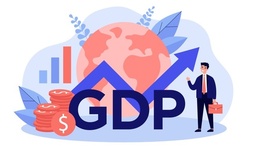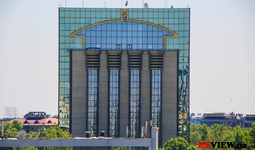According to the State Committee on Statistics, the gross domestic product for January-December increased by 1.6% and amounted to 580.2 trillion. soums.
The return of most sectors of the economy to normal functioning in the fourth quarter made it possible to increase production activity, while in the first three quarters the economy continued to grow weak at 0.4%.
In neighboring countries and major trading partners, the pandemic has also had a significant impact on economic development. At the end of the year, Kazakhstan's GDP decreased by 2.6% against growth by 4.5% in 2019.In Russia, at the end of the year, the decline in annual GDP was estimated at 3.8%. GDP of Kyrgyzstan in January-December 2020 decreased by 8.6%. At the same time, the Chinese economy grew by 2.3% in 2020, but this is the lowest growth rate in the last 45 years.
Inflation in Uzbekistan continues to decline. The annual consumer price index was 11.1% by December 2019, compared to 15.2% in 2019. A slowdown in price growth in comparison with the previous year is noted for food, non-food products and services. At the same time, the main driver of inflation is still the growth in food prices by 15.3% (in 2019 by 18.6%).
One of the noticeable consequences of the pandemic was a decrease in investment activity. The volume of investments in fixed assets decreased by 8.2%. At the same time, it should be noted that a decline is noted in centralized investments by almost 35%, mainly due to a reduction in investments from the budget by 33.6% and foreign investments and loans guaranteed by the government by 28%. The volume of investments from non-centralized sources, on the contrary, grew by 2% at the end of the year, mainly due to an increase in investments at the expense of enterprises by 11.2%.
All sectors of the economy managed to maintain production growth.
The production volume of agriculture, forestry and fisheries increased by 3%. At the same time, it is necessary to note the double growth dynamics in the fisheries sector at the level of 19.8%, the development of which in recent years has received increased attention from the state.
By the end of the year, the industry managed to overcome the recession observed during April-October and reach a modest growth of 0.7%. The main driver was the manufacturing industry, which increased production volumes by 7.1%, which is even higher than the growth in 2019 by 6.6%. Among the manufacturing industries in 2020, the largest increase in production is observed in the production of electronic, optical and computer products by 70.6% (but its share in the total volume of industrial production remains relatively low - 0.9%), textile production by 15.4% , finished metal products by 14.8%, pharmaceutical products by 13.4%, food products by 8.7%, etc. In the mining industry, on the contrary, there is a rather serious decline - by almost 22%, including due to the decline extraction of natural gas, gravel, crushed stone. Also worth noting is a 12.5% increase in electricity, gas, steam and air conditioning.
In the construction sector, although growth rates slowed down from 22.9% in 2019 to 9.1% at the end of 2020, they still have a high level of dynamics.
The service sector, despite the serious negative impact of the pandemic on the areas of accommodation and food, passenger transportation, retail and wholesale trade, was also able to maintain positive dynamics at the level of 2.3% at the end of the year, while in 2019 the growth was 13.2% ... The volume of retail trade in 2020 increased by 3.2%. In the field of transport, there is a decline in key indicators. Thus, cargo turnover decreased by 4.8%, passenger turnover by 16.7%, which is not surprising, given two periods of strict restrictive measures on transportation in the country, as well as a decline in demand for exported products in foreign markets.
The pandemic negatively affected the foreign trade of the republic. At the end of the year, foreign trade turnover decreased by 13.1% to $ 36.3 billion. The volume of exports amounted to $ 15.1 billion, having decreased by 13.4% compared to the same period of the previous year. The volume of imports also decreased by 12.8% to $ 21.2 billion. The foreign trade balance was negative - $ 6 billion.
In the structure of export, the main decline was in services - by 41.7%, and exports of energy carriers and oil products - by 73.9%. Also, the value of exports of fruits and vegetables decreased by 16.5%. At the same time, the export of textiles and clothing increased by 18.1% to 1.9 billion dollars of gold - by 18%, machinery and equipment - by 9.4%, ferrous metals and products from them - by 4%. In the structure of import, the decline was mainly noted for services by almost 50%, ferrous metals and their products - by 20%, machinery and equipment - by 16.2%.
Uzbekistan, in the context of the pandemic and the recession caused by it in the economies of other countries, was able to maintain a positive dynamic of economic growth. The use of targeted restrictive measures, based on the epidemiological situation, made it possible to avoid the complete close of the work of most enterprises and to proceed to the restoration of business activity. The fourth quarter was relatively calm for the economy, which created the necessary conditions for a return to the usual rhythm of life of enterprises and an increase in production. Thus, despite all the difficulties, the slowdown in economic growth, the Uzbek economy has demonstrated resilience to shocks.
Ruslan Abaturov, Center for Economic Research and Reforms
Niyazmatov Timur translation, Center for Economic Research and Reforms





















leave a comment